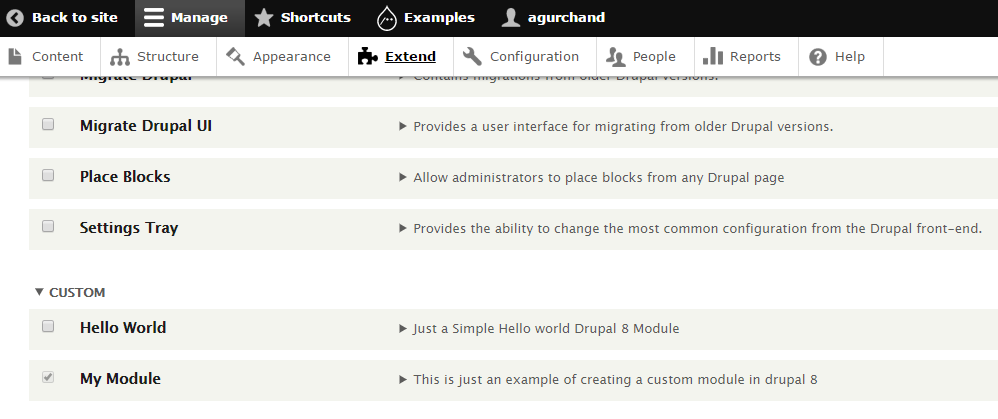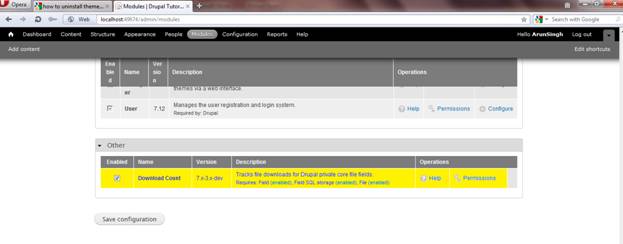
I am testing a custom module for a site using Panels Everywhere & Panels. I need to put the results of a Devel module dpm() message into a pane so that I can see it on page displays. Does anyone know what content type it might be? I assumed it would be System Help, but [ ] I am testing a custom module for a site using Panels Everywhere & Panels Mar 13, · The features module enables the capture and management of features in Drupal. A feature is a collection of Drupal entities which taken together satisfy a certain use-case. Features provides a UI and API for taking different site building components from modules with exportables and bundling them together in a single feature module. A feature module is like any other Drupal Drupal 8 multi value field. twig - Drupal. g. 0. # See example. In fact, using conditional statements in nodes or page templates is quite easy. This validated CSV would need to be imported into Drupal 8 into various content types. 'key' is the first level of the database connection
How to Create a Custom Drupal 9 Theme in 9 Simple Steps | Specbee
Nick Schäferhoff. Drupal is a free, powerful content management system that lets you create custom how to write custom module in drupal, blogs, portals, and more. It has all the features you need to build a fully functional website, is highly customizable, scalable, and free to use.
In this step-by-step Drupal tutorial, we will show you how to build a website using the latest version of the Drupal CMS which at the time of this writing is Drupal 9. However, using Drupal is not as easy as creating a website with WordPress or website builders. Total time to create a website using Drupal: ~ hours Skill level: Intermediate. If this is the first time using this CMS, you might be asking yourself what exactly Drupal is suitable for.
It turns out, Drupal can be used to create almost any kind of website:. This versatility has resulted in the fact that a number of prominent users rely on Drupal to power their websites, including:. You can find additional examples in the Drupal showcase section. To summarize, whatever website you are aiming to build, Drupal allows you to do so. And as a Drupal user, you will be in good company. Before you can build a website, you need a place where it is located and reachable aka web hosting.
Already have hosting? Move on to step 2 of the Drupal tutorial. You can check our list of the top 10 web hosting providers to find the right option for you for building a Drupal site, we especially recommend Bluehost.
Most providers should have the right system requirements for Drupal see the documentation. The best among them e. The other is to download and install Drupal manually. From how to write custom module in drupal, use the search field in the upper left corner to search for Drupal and click on the result when you have found it.
Then, hit Install Now. Fill in your admin username, password, and email address. Before the installation can continue, you will likely get a message like this:. Simply check the box and click Install again. The installation will then start.
Well done! If you are not using Bluehost or a web host that can automatically install Drupal, you can also set it up manually. As the first step, go to the download section of the official Drupal website and hit the big blue button. Once on your hard drive, unzip the file you just downloaded.
Then, connect to your server via FTP e. with FileZilla and start uploading its contents to the server location that your domain is pointed at usually the root directory. This will take a bit. Here, be sure to create a dedicated database for your Drupal installation. While the process will be slightly different depending on your provider, you should end up with the following:.
Once the files have finished uploading, navigate to your site domain. Doing so will start the Drupal installation process. The first step is to choose the language you want your site to operate in. Take your pick and click Save and continue. After that, you need to choose your so-called installation profile. This determines whether some of your site features will be pre-configured or not. The choices here might differ depending on the distribution of Drupal you are using, how to write custom module in drupal.
Again, make your choice and move on. For this tutorial, we go with the standard Drupal profile. If you are more experienced, you may also use a minimal option. In the next step, the installation checks whether your environment is sufficient to run the software. Any problems will show up as warnings so you can address them.
Continue when you are satisfied. Input the database name, user how to write custom module in drupal, and how to write custom module in drupal. If your MySQL host address is not localhostyou can change it under Advanced Options.
In the same place, you can also assign a database prefix if needed for example, when you have several sites in one database. Save and continue once you are done. In the end, you need to decide whether your site should check for updates automatically and notify you if any are available. When satisfied, save once more and you are done with the installation. After you have finished the installation process, how to write custom module in drupal, this is what your newly created Drupal site will look like:.
By the way, under Shortcuts, you can define your own links to parts of the admin interface that you use often. That way, you can improve your workflow and make it faster. All clear? At the bottom, you see the front end of your site, meaning what your visitors will see. However, unlike other content management systems, it is not possible to find themes from inside the Drupal back end.
For that, you need to go to the official Drupal theme directoryfor which you also find a link at the top of the theme installation page.
At the time of this writing, you have a choice of more than 2, themes, how to write custom module in drupal.
The directory gives you several ways of filtering them so you can find what you are looking for. However, you might still be overwhelmed by the sheer number. Reviewing themes is a bit beyond a Drupal tutorial for beginners. When choosing a theme, make sure it fits your level of technical ability, allows you to create the design vision you have in mind, and is mobile responsive a must these days. All themes in the directory also have their own page where you can read up on their details and check out a live demo.
When you have found the right one, installing it on your site is quite easy. Either download the theme from the directory you find options at the bottom or right-click the download link and copy its location, how to write custom module in drupal. After that, you still need to install it from the Appearance tab and activate it called Set as default in Drupal.
When you have done so and you go back to your site there is a button in the upper left corneryou can see the new theme in action. Once you have installed and activated a new site theme, you find it at the top of the list in how to write custom module in drupal Appearance menu. Most themes come with configuration options that you can access by clicking the Settings link next to them, how to write custom module in drupal.
Alternatively, use the Settings tab on top and then pick the theme that you want to edit. Here, you are able to make any changes that your theme offers and, depending on your theme, even preview it at the same time. When you build a website with Drupal, definitely make sure to swing by here so you can take advantage of everything your theme has to offer.
Drupal not only allows you to change the front end of your site with themes, but it also offers the same possibility for the back end.
One thing you can how to write custom module in drupal out is the experimental new back-end default theme called Claro that Drupal 9 ships with. You can find it under Uninstalled themes in the Appearance menu. After that, you can choose the new back end theme from the drop-down menu under Administration theme. There are other admin themes, you can find additional examples here. Some of them also come with their own modules to add extra functionality.
Now your site looks better but it is still pretty empty. Changing that is the next step in our Drupal tutorial. For starters, we want to create a front page so that visitors get to see something when they swing by. It will take you to this screen:. Here, you are able to create content with a basic editor.
At the top, you have the option to define a page title that will also appear on your site. Below that, you find a link that says Edit summary. When you click it, it gives you the option to provide a summary for your post or page. This is kind of like an excerpt that will appear in how to write custom module in drupal parts of your site. Below that, there is the option to input and format the body text.
For example, you can make the text bold and italic, add and remove links, create lists, define block quotes, insert images, and use the drop-down menu to define headings. Additional options such as inputting tables or horizontal dividers are available when you switch to Full HTML at the bottom.
If you have ever worked with a word processor or any other content management system, you should find your way around quickly and be able to put together the content you want. Once you are done, make sure that on the right side under URL Aliasyou define a slug or URL ending for your page.
After that, at the bottom, save the post and make sure that the box before Published is ticked. Here, under the Default front pageinput the same slug that you just defined for your new page. Once you have done that and saved the configuration, your content should show up on the front page of your Drupal site. As a next step, we now want to create an About page and add it as a menu item.
How to create a custom module in drupal?
, time: 7:17Drupal 8 multi value field

Mar 13, · The features module enables the capture and management of features in Drupal. A feature is a collection of Drupal entities which taken together satisfy a certain use-case. Features provides a UI and API for taking different site building components from modules with exportables and bundling them together in a single feature module. A feature module is like any other Drupal Drupal (/ ˈ d r uː p əl /) is a free and open-source web content management system (CMS) written in PHP and distributed under the GNU General Public License. Drupal provides a back-end framework for at least 13% of the top 10, websites worldwide – ranging from personal blogs to corporate, political, and government sites. Systems also use Drupal for knowledge management and for business Drupal 8 multi value field. twig - Drupal. g. 0. # See example. In fact, using conditional statements in nodes or page templates is quite easy. This validated CSV would need to be imported into Drupal 8 into various content types. 'key' is the first level of the database connection
No comments:
Post a Comment